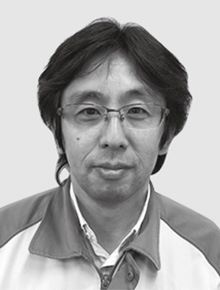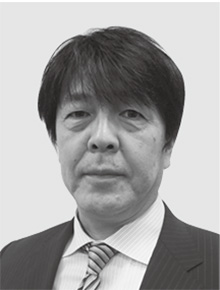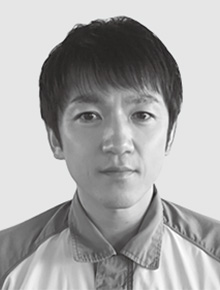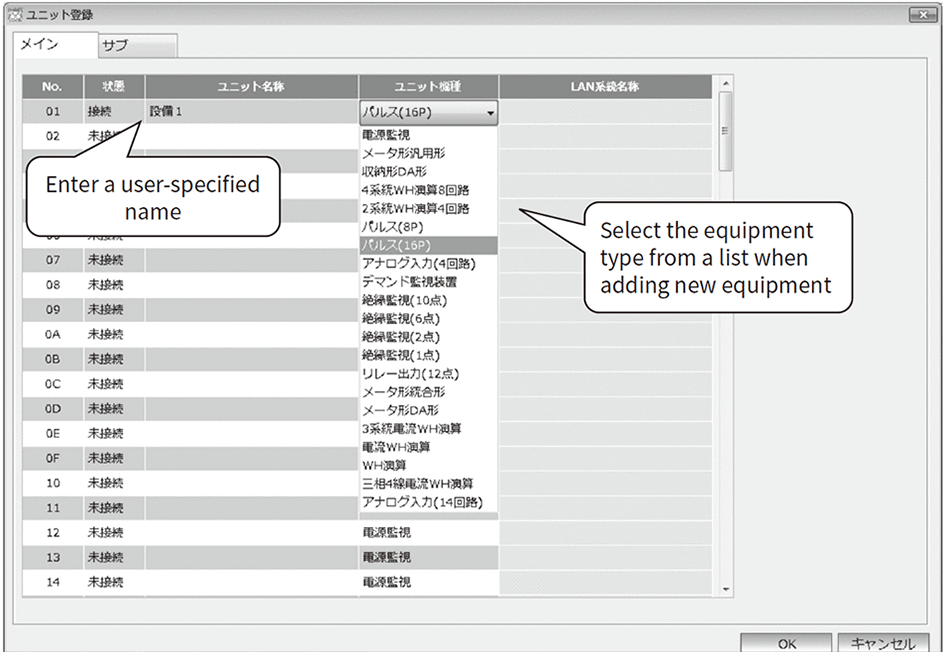Services, Systems, and Products for Smarter FactoriesMonitoring System for Power Transmission, Distribution Equipment to Ensure Stable Supply
Highlight
Electric power is essential to the functioning of society, such that power outages have the potential to impact heavily on people’s daily lives as well as on economic activity. In order to use power reliably and efficiently, it is important that electricity users such as factories, office buildings, and railways continuously monitor their usage and electrical equipment status so that information is available on the voltages, currents, and other parameters from across the distribution network, and they need to track how these vary over both the short and long term. To satisfy this need, Hitachi supplies its ES-MACS (high-voltage) and H-NET (low-voltage) monitoring/control systems for power transmission, distribution, and utilities that help achieve energy efficiency. Another function included in these systems is one that monitors insulation. This contributes to reliable electricity use and helps to prevent faults caused by aging or deteriorating equipment by enabling information collection and monitoring to be performed across in-service equipment in both high-voltage and low-voltage systems. This article describes these systems and services supplied by Hitachi to ensure a stable supply of electric power.

1. Introduction
Electricity is an important part of the infrastructure and continuous status monitoring of electrical equipment is important for maintaining power supply stability. Hitachi supplies two monitoring/control systems for power transmission, distribution, and utilities: the ES-MACS system for high voltages (mainly 6.6 kV or more) and the H-NET system for low voltages (mainly 400 V or less). This article describes the features of these systems as well as an insulation monitoring function that can detect intermittent ground faults in power cables and provides an example of preventive maintenance.
2. Role of Monitoring Systems
2.1 Equipment Status Monitoring and Control
Fig. 1—ES-MACS System (Top) and Monitoring Screen (Bottom) The system is based on a personal computer and features intuitive display and operation.
The system is based on a personal computer and features intuitive display and operation.
Table 1—Examples of ES-MACS Functions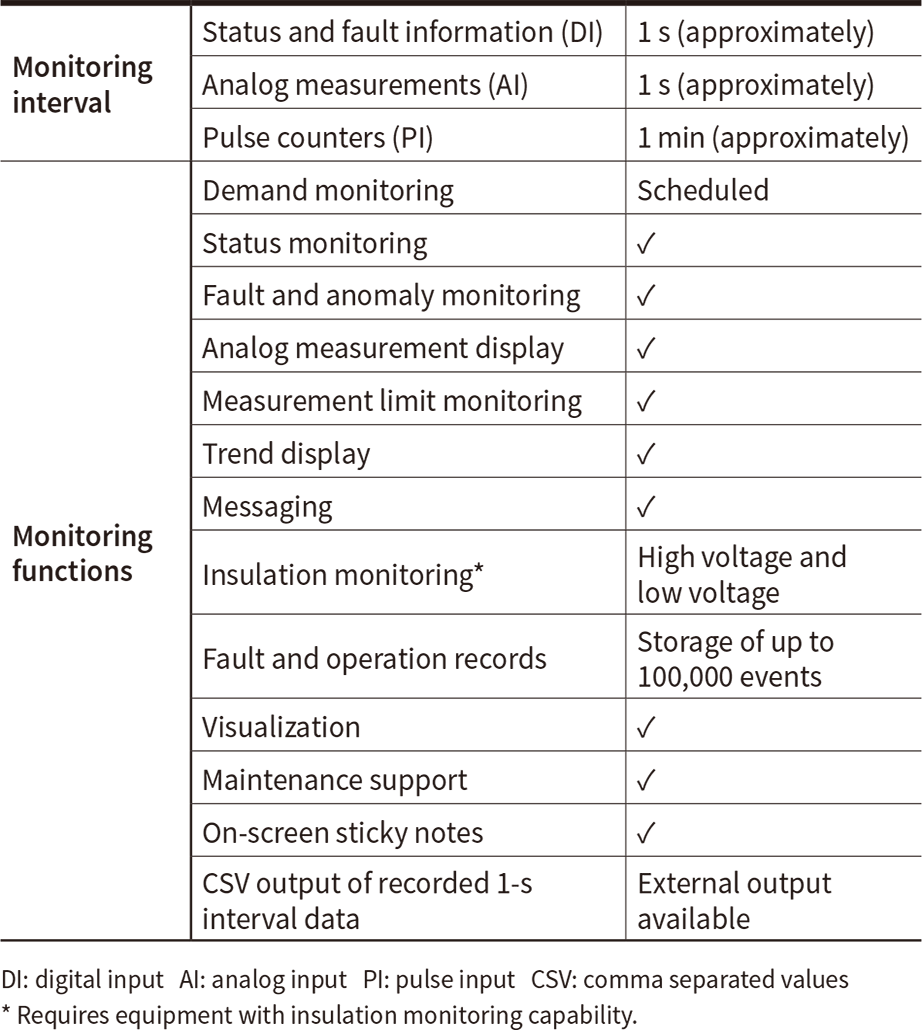 The system provides a full set of functions for safe and reliable equipment operation.
The system provides a full set of functions for safe and reliable equipment operation.
The safe and efficient operation of electrical equipment requires the collection of voltage, current, power, and power factor measurements from the various circuits to monitor for changes in equipment status and so that automatic or manual control actions can be taken in response to such changes. The following are typical examples of control actions and features.
- Automatic voltage control
Drops in the voltage supplied to electrical equipment can cause motors to slow. Too high a voltage can result in the breakdown of insulation. This makes it necessary to monitor voltage and to make adjustments if it falls or rises. - Automatic power factor control
As a poor power factor results in higher electrical losses, this parameter is an important one for both users and grid operators. Accordingly, monitoring and control of power factors is needed to maintain efficient operation. - Demand prediction
How much electric power can be used is stipulated in the contract with the utility and this level should never be exceeded. This means it is necessary for users to always keep track of and predict electricity usage so that action can be taken to reduce usage if the contracted supply is at risk of being exceeded.
Monitoring systems are vital for the operation of electrical equipment that handles measurement and monitoring of all of the different parameters and their control, and these systems need to support everything from long-term monitoring to planning for equipment upgrades. The ES-MACS system for electricity transmission and distribution and the monitoring of high-voltage equipment is one such Hitachi system. Figure 1 shows a photograph and example screen, and Table 1 lists its main functions.
2.2 Energy Efficiency
An important requirement for achieving energy efficiency is to obtain an overview of electricity usage by using monitoring devices to collect data on how much power is used by each item of equipment. Because electrical loads come in such complex varieties and are connected in a tree configuration that runs from high-voltage down to low-voltage circuits, the monitoring equipment must be able to work with a wide variety of signal interfaces and handle a large number of signal inputs in order to collect information from all measurement points.
Hitachi’s H-NET distribution and utilities monitoring system for low-voltage equipment supports the connection of up to 121 units, with communication cabling between units up to 4.8 km in length. These capabilities make it suitable for collecting data on electricity usage to enhance energy efficiency. The following signal interfaces are supported.
- Electricity monitoring unit and electrical energy calculation unit
These units measure power supply data, including voltage, current, power, and electricity usage. - Pulse input units
These units monitor utilities such as gas, water, and oil, and also equipment status (at the point of connection). - Analog input units
These units input analog values from temperature, concentration, and other sensors [4-20 mA or 1-5 V direct current (DC)] - Insulation monitoring units
These units measure the condition of insulation in low-voltage equipment and cables.
The system also provides a wide variety of screens showing measurement values, demand monitoring, trend graphs, reports, skeleton diagrams, and warning information. Screens can also be customized by the user. These functions allow H-NET to be used to determine the potential for enhancing the energy efficiency of particular items of equipment based on collected data, and to investigate and suggest where the best return on investment in equipment is to be found.
Figure 2 shows the different H-NET units and a system configuration. Figure 3 and Figure 4 show software and settings screens.
Fig. 2—H-NET Units (Top) and System Configuration (Bottom) H-NET units are equipped with a variety of signal interfaces. Along with information on electrical energy, they can also be used to collect information for quality, environmental, and safety management.
H-NET units are equipped with a variety of signal interfaces. Along with information on electrical energy, they can also be used to collect information for quality, environmental, and safety management.
2.3 Preventive Maintenance
Fig. 5—Ground Fault Waveform for Intermittent Arcing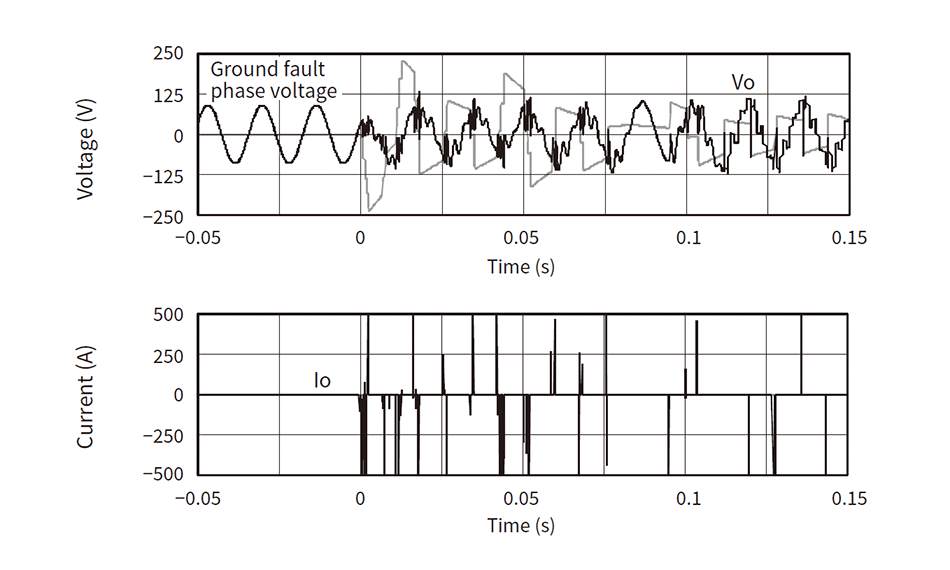 The figure shows the measured waveform for intermittent arcing obtained in an experiment.
The figure shows the measured waveform for intermittent arcing obtained in an experiment.
Fig. 6—Mechanism of Insulation Degradation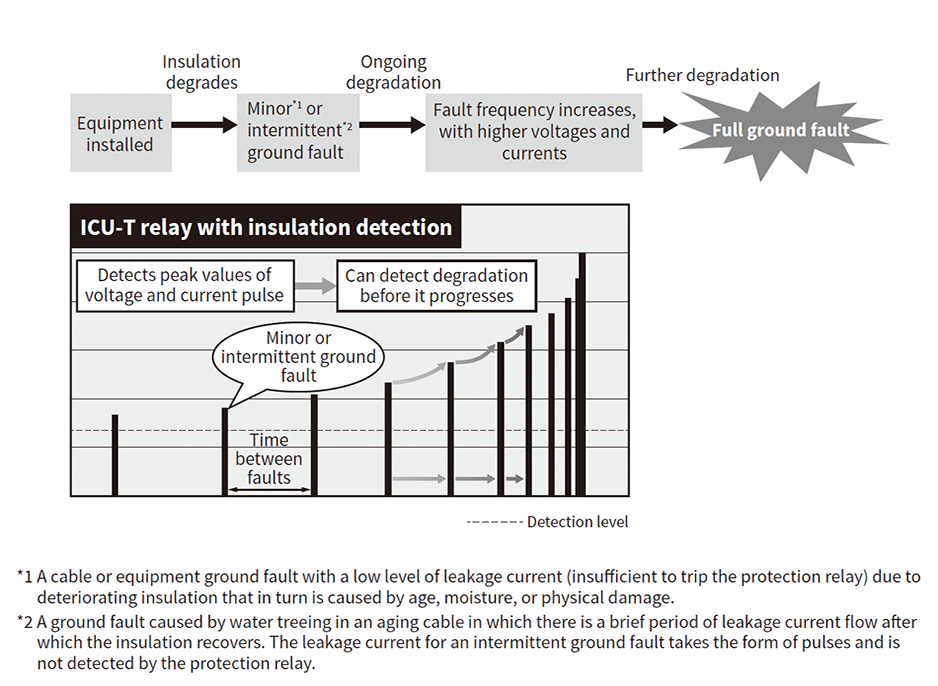 The figure shows how an intermittent ground fault can transform into a full ground fault.
The figure shows how an intermittent ground fault can transform into a full ground fault.
A common cause of faults in electrical equipment is when deteriorating insulation results in a ground fault. Unfortunately, the difficulty of assessing the condition of insulation in equipment while it is operating means that a common practice is to shut equipment down periodically to perform safety checks in which the state of the insulation is inspected. However, turning off the electric power to modern manufacturing plants and service businesses is problematic, making it difficult to combine high utilization and safety. Accordingly, what is needed to reduce unexpected power outages, improve equipment utilization, and cut inspection costs is a means of checking the condition of equipment insulation while it is in service so that, by keeping track of any deterioration, power-off inspections need only be done when absolutely necessary. To achieve this, Hitachi supplies an insulation monitoring system that can monitor the degree of degradation in power cable insulation during operation.
Ground faults characterized by intermittent arcing are a common consequence of degraded power cable insulation. The leakage current from these faults is intermittent as the insulation recovers after a few hundred milliseconds, extinguishing the arc. Furthermore, the timing of fault events is sporadic, and a long time may pass between one instance of intermittent arcing and the next, although the time between recovery and the next fault tends to get progressively shorter and often leads ultimately to full insulation breakdown (a non-intermittent ground fault). Hitachi’s system detects this intermittent arcing (which serves as an early warning of a full ground fault), meaning it can prevent faults quickly and efficiently by making this information available so that places where insulation has degraded can be caught early and remedial action taken. This function for detecting degraded insulation is also included in Hitachi’s protection relay ICU-T described below, making it possible to identify the location and phase of intermittent arcing without the need to install additional equipment. Figure 5 shows an example waveform for intermittent arcing and Figure 6 shows the mechanism of insulation degradation.
3. Components that Support Technology
3.1 ICU-T
Fig. 7—ICU-T Relay with Insulation Monitoring and Example Circuit Diagram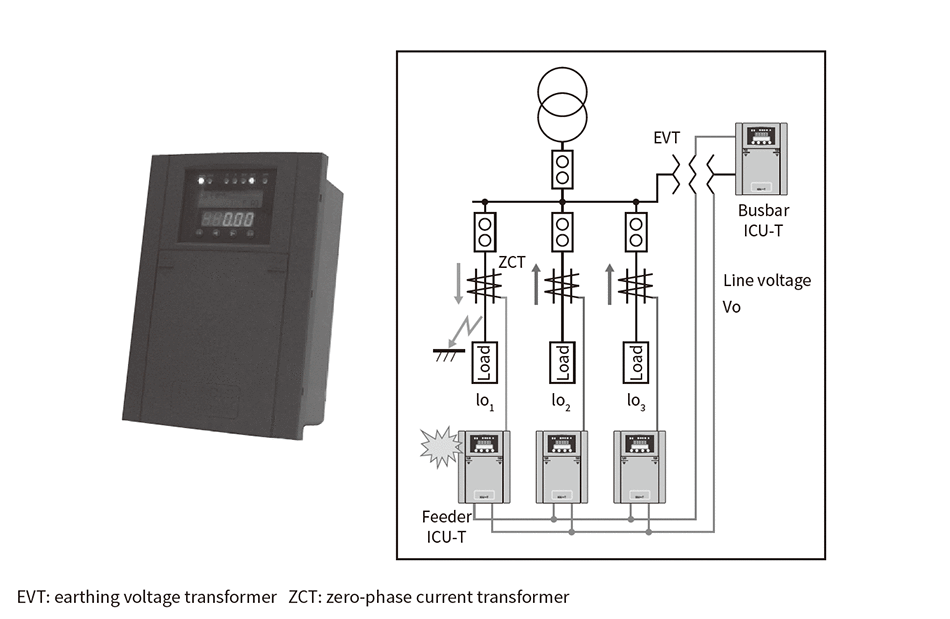 Flexibility of configuration is provided to suit different customer requirements.
Flexibility of configuration is provided to suit different customer requirements.
Protection relays take inputs from the devices used in electrical equipment and use this information for the early detection of anomalies and the tripping of circuit breakers to prevent faults in the equipment or distribution network from affecting other systems. As Hitachi’s protection relay ICU-T combines functions for measurement, protection, control, and communication, it is equipped with a high-performance central processing unit (CPU) and boast a number of features, including compact design, high reliability, more control over protection characteristics, and access to digital data. Its ability to work with wide-range current transformers (CTs) means that changes in load capacitance do not force replacement of the CT.
ICU-T relays with a built-in function for detecting degradation in power cable insulation serve as the detectors in Hitachi’s insulation monitoring system. They can detect not only full or minor ground faults, but also intermittent arcing without the need for additional equipment, and to transmit this information to a higher-level system. ICU-T relays with insulation monitoring are supplied in two different types, one for monitoring entire busbars and another for feeder circuit monitoring. As a single ICU-T busbar relay can monitor the insulation for the entire secondary side of a transformer, it provides an effective way to identify potential problems across all the connected equipment. The feeder relay can also identify fault location (circuit and phase), providing an easy way to determine which cable needs to be replaced before turning off the power. Hitachi uses these two types of ICU-T protection relay to satisfy different customer requirements. Figure 7 shows a photograph of an ICU-T relay with insulation monitoring and an example circuit diagram.
3.2 Transformers
Distribution transformers are widely used at factories, office buildings, and other such facilities. Having been designated as “specified equipment*1” by Japan’s Ministry of Economy, Trade and Industry, they are required to have high energy efficiency. Hitachi’s amorphous transformers exceed the energy efficiency requirements*2 of the Top Runner*3 standard.
The main features of these transformers are as follows.
- High energy efficiency
Use of the latest amorphous alloy in the transformer cores means their no-load losses are approximately one-third less than those of transformers made from conventional electrical steel, providing them with industry-leading levels of energy efficiency at up to 166% of the Top Runner standard. - Wide product range
The product range covers all the rated capacities specified in the Japanese Industrial Standards (JIS) from single-phase 10-kVA to three-phase 2,000-kVA models. Hitachi is also the first in the industry to offer tie transformers*4 with an amorphous core. Table 2 lists the specifications for amorphous transformers.
Table 2—Amorphous Transformer Specifications The table lists the different amorphous transformers available from Hitachi. The product lineup covers all the JIS rated capacities from single-phase 10-kVA to three-phase 2,000-kVA models.
The table lists the different amorphous transformers available from Hitachi. The product lineup covers all the JIS rated capacities from single-phase 10-kVA to three-phase 2,000-kVA models.
- *1
- Devices that are identified in the Law Concerning the Rational Use of Energy (Energy Conservation Act) as being obliged to have high energy efficiency.
- *2
- The second round of criteria under the Top Runner standard for transformers.
- *3
- A standard for the energy efficiency of equipment stipulated in the Energy Conservation Act.
- *4
- Transformers that convert from 6 kV to 3 kV.
4. Conclusions
This article has described Hitachi electrical equipment designed for greater energy efficiency that also serves as an effective means of preventing accidents by extending monitoring for insulation degradation across high- and low-voltage systems. To contribute to the stable supply of electric power in the future, Hitachi intends to continue working to enhance collected information and on more precise forms of preventive maintenance by means of databases that use the cloud.


